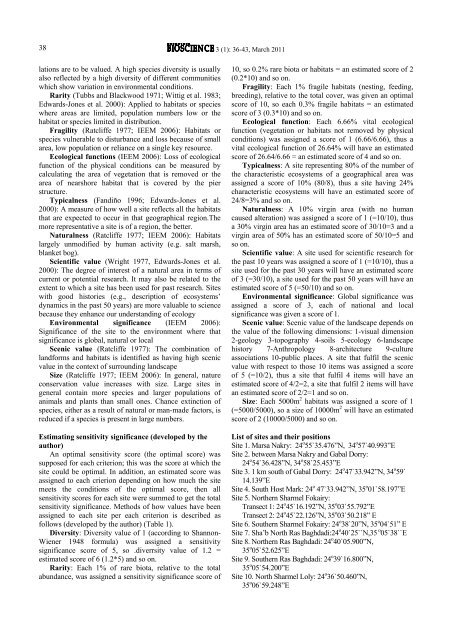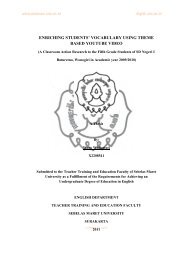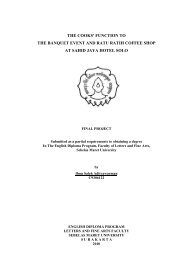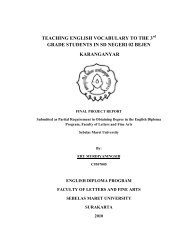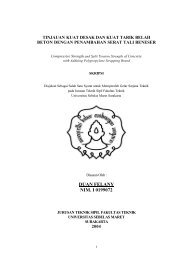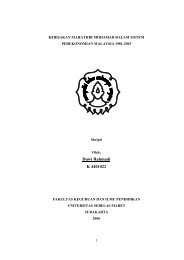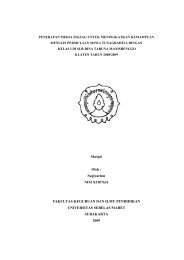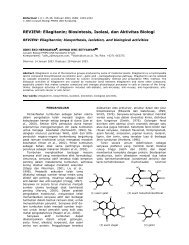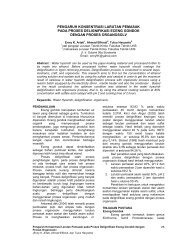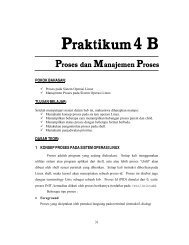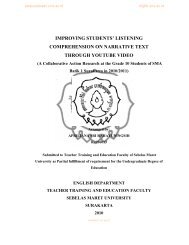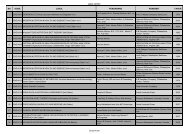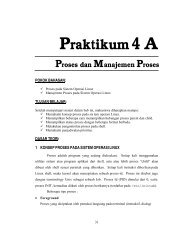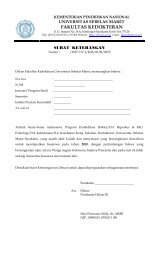ISSN 2087-3940 (PRINT) | ISSN 2087-3956 ... - Biodiversitas
ISSN 2087-3940 (PRINT) | ISSN 2087-3956 ... - Biodiversitas
ISSN 2087-3940 (PRINT) | ISSN 2087-3956 ... - Biodiversitas
Create successful ePaper yourself
Turn your PDF publications into a flip-book with our unique Google optimized e-Paper software.
38<br />
3 (1): 36-43, March 2011<br />
lations are to be valued. A high species diversity is usually<br />
also reflected by a high diversity of different communities<br />
which show variation in environmental conditions.<br />
Rarity (Tubbs and Blackwood 1971; Wittig et al. 1983;<br />
Edwards-Jones et al. 2000): Applied to habitats or species<br />
where areas are limited, population numbers low or the<br />
habitat or species limited in distribution.<br />
Fragility (Ratcliffe 1977; IEEM 2006): Habitats or<br />
species vulnerable to disturbance and loss because of small<br />
area, low population or reliance on a single key resource.<br />
Ecological functions (IEEM 2006): Loss of ecological<br />
function of the physical conditions can be measured by<br />
calculating the area of vegetation that is removed or the<br />
area of nearshore habitat that is covered by the pier<br />
structure.<br />
Typicalness (Fandiño 1996; Edwards-Jones et al.<br />
2000): A measure of how well a site reflects all the habitats<br />
that are expected to occur in that geographical region.The<br />
more representative a site is of a region, the better.<br />
Naturalness (Ratcliffe 1977; IEEM 2006): Habitats<br />
largely unmodified by human activity (e.g. salt marsh,<br />
blanket bog).<br />
Scientific value (Wright 1977, Edwards-Jones et al.<br />
2000): The degree of interest of a natural area in terms of<br />
current or potential research. It may also be related to the<br />
extent to which a site has been used for past research. Sites<br />
with good histories (e.g., description of ecosystems’<br />
dynamics in the past 50 years) are more valuable to science<br />
because they enhance our understanding of ecology<br />
Environmental significance (IEEM 2006):<br />
Significance of the site to the environment where that<br />
significance is global, natural or local<br />
Scenic value (Ratcliffe 1977): The combination of<br />
landforms and habitats is identified as having high scenic<br />
value in the context of surrounding landscape<br />
Size (Ratcliffe 1977; IEEM 2006): In general, nature<br />
conservation value increases with size. Large sites in<br />
general contain more species and larger populations of<br />
animals and plants than small ones. Chance extinction of<br />
species, either as a result of natural or man-made factors, is<br />
reduced if a species is present in large numbers.<br />
Estimating sensitivity significance (developed by the<br />
author)<br />
An optimal sensitivity score (the optimal score) was<br />
supposed for each criterion; this was the score at which the<br />
site could be optimal. In addition, an estimated score was<br />
assigned to each crierion depending on how much the site<br />
meets the conditions of the optimal score, then all<br />
sensitivity scores for each site were summed to get the total<br />
sensitivity significance. Methods of how values have been<br />
assigned to each site per each criterion is described as<br />
follows (developed by the author) (Table 1).<br />
Diversity: Diversity value of 1 (according to Shannon-<br />
Wiener 1948 formula) was assigned a sensitivity<br />
significance score of 5, so .diverrsity value of 1.2 =<br />
estimated score of 6 (1.2*5) and so on.<br />
Rarity: Each 1% of rare biota, relative to the total<br />
abundance, was assigned a sensitivity significance score of<br />
10, so 0.2% rare biota or habitats = an estimated score of 2<br />
(0.2*10) and so on.<br />
Fragility: Each 1% fragile habitats (nesting, feeding,<br />
breeding), relative to the total cover, was given an optimal<br />
score of 10, so each 0.3% fragile habitats = an estimated<br />
score of 3 (0.3*10) and so on.<br />
Ecological function: Each 6.66% vital ecological<br />
function (vegetation or habitats not removed by physical<br />
conditions) was assigned a score of 1 (6.66/6.66), thus a<br />
vital ecological function of 26.64% will have an estimated<br />
score of 26.64/6.66 = an estimated score of 4 and so on.<br />
Typicalness: A site representing 80% of the number of<br />
the characteristic ecosystems of a geographical area was<br />
assigned a score of 10% (80/8), thus a site having 24%<br />
characteristic ecosystems will have an estimated score of<br />
24/8=3% and so on.<br />
Naturalness: A 10% virgin area (with no human<br />
caused alteration) was assigned a score of 1 (=10/10), thus<br />
a 30% virgin area has an estimated score of 30/10=3 and a<br />
virgin area of 50% has an estimated score of 50/10=5 and<br />
so on.<br />
Scientific value: A site used for scientific research for<br />
the past 10 years was assigned a score of 1 (=10/10), thus a<br />
site used for the past 30 years will have an estimated score<br />
of 3 (=30/10), a site used for the past 50 years will have an<br />
estimated score of 5 (=50/10) and so on.<br />
Environmental significance: Global significance was<br />
assigned a score of 3, each of national and local<br />
significance was given a score of 1.<br />
Scenic value: Scenic value of the landscape depends on<br />
the value of the following dimensions: 1-visual dimension<br />
2-geology 3-topography 4-soils 5-ecology 6-landscape<br />
history 7-Anthropology 8-architecture 9-culture<br />
associations 10-public places. A site that fulfil the scenic<br />
value with respect to those 10 items was assigned a score<br />
of 5 (=10/2), thus a site that fulfil 4 items will have an<br />
estimated score of 4/2=2, a site that fulfil 2 items will have<br />
an estimated score of 2/2=1 and so on.<br />
Size: Each 5000m 2 habitats was assigned a score of 1<br />
(=5000/5000), so a size of 10000m 2 will have an estimated<br />
score of 2 (10000/5000) and so on.<br />
List of sites and their positions<br />
Site 1. Marsa Nakry: 24 o 55`35.476”N, 34 o 57`40.993”E<br />
Site 2. between Marsa Nakry and Gabal Dorry:<br />
24 o 54`36.428”N, 34 o 58`25.453”E<br />
Site 3. 1 km south of Gabal Dorry: 24 o 47`33.942”N, 34 o 59`<br />
14.139”E<br />
Site 4. South Host Mark: 24 o 47`33.942”N, 35 o 01`58.197”E<br />
Site 5. Northern Sharmel Fokairy:<br />
Transect 1: 24 o 45`16.192”N, 35 o 03`55.792”E<br />
Transect 2: 24 o 45`22.126”N, 35 o 03`50.218” E<br />
Site 6. Southern Sharmel Fokairy: 24 o 38`20”N, 35 o 04`51” E<br />
Site 7. Sha’b North Ras Baghdadi:24 o 40`25``N,35 o 05`38``E<br />
Site 8. Northern Ras Baghdadi: 24 o 40`05.900”N,<br />
35 o 05`52.625”E<br />
Site 9. Southern Ras Baghdadi: 24 o 39`16.800”N,<br />
35 o 05`54.200”E<br />
Site 10. North Sharmel Loly: 24 o 36`50.460”N,<br />
35 o 06`59.248”E


